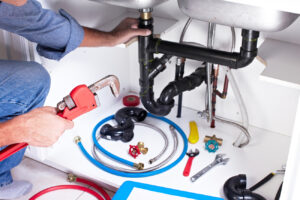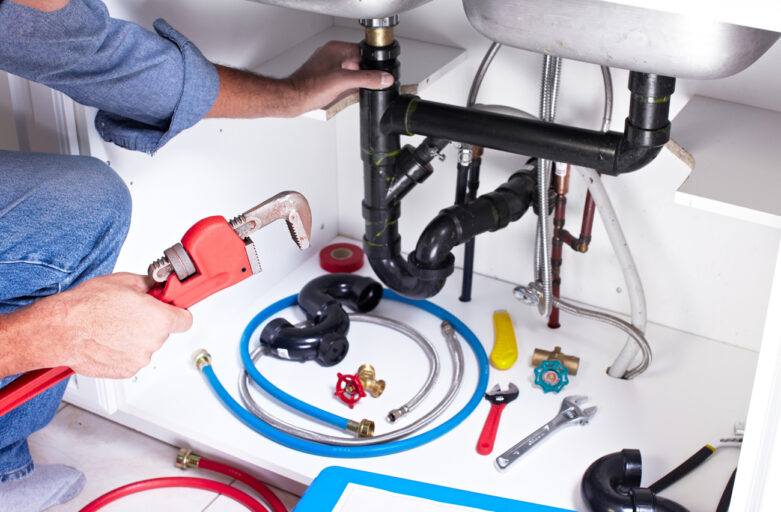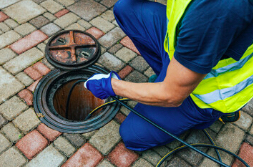Joe’s Plumbing is a complex pipe network that brings fresh water into homes and carries waste out. It requires high skill and knowledge to design and install systems that meet building codes and provide safe, potable water.
Plumbers also need to have strong problem-solving skills to identify and fix issues in existing systems. They must be able to listen to customers’ concerns and understandably explain technical information.

The water supply system is the infrastructure for collecting, transporting, and delivering purified water to consumers. This service is vital for cities’ and towns’ economies and daily lives. It also enables the delivery of other lifeline services such as electric power, gas and liquid fuels, communications, transportation, and waste disposal. The water supply system may also include the sewers (as separate systems) and other related facilities, such as reservoirs and cisterns.
The basic components of a water supply system are the source, treatment plant, and distribution system. The source may be groundwater or surface water. Treatment processes typically include filtration, disinfection through chlorination, and fluoridation. The water may then be stored in reservoirs or cisterns, which may be aboveground or underground. It is then distributed to consumers through a network of pipes. This pipe network normally consists of a grid with loops to avoid dead ends. This allows the system to continue serving customers even if any section needs to be removed or repaired for maintenance or contamination.
These networks can be very complex and expensive to design, build, operate, and maintain. They must satisfy quality and quantity requirements for domestic, commercial, and industrial uses and public needs such as firefighting. In addition, they must withstand natural events such as earthquakes and floods.
Most public water supply systems are regulated by State agencies, which collect data about the population served and sources of supply. The data are compiled into the Public Drinking-Water Supply File in the Federal Research Data Set. The File contains information on public water supply systems that serve at least 25 people or have a minimum of 15 service connections. Public water supply systems are usually grouped into large and small categories based on criteria specific to each utility.
In addition to the technical challenges such systems pose, water-supply infrastructure must cope with the risks of contamination and disease transmission. Contaminated drinking water, or contaminated wastewater, can enter the distribution system from many different sources. These sources may be direct, such as a physical connection between the safe and unsafe systems, or indirect, such as a structural arrangement that permits nonpotable water to flow back into the potable system.
Waste disposal refers to the process of getting rid of discarded materials. Disposing of waste properly is important because it helps reduce environmental pollution. It is also beneficial to the economy because it provides jobs and revenue.
Waste is classified according to its characteristics and disposed of using different methods. The different types of waste include municipal solid waste, industrial non-hazardous waste, hazardous waste, and sewage sludge. In addition, there are special kinds of waste require more stringent disposal procedures, such as asbestos and nuclear waste.
The main waste disposal methods are landfills, surface impoundments, and land farming. Waste is buried in soil layers and covered with a clay cap in landfills. It is also compacted to prevent it from settling unevenly and is lined with plastic or clean soil. There are also vent pipes that allow the gases produced by waste decomposition to escape into the atmosphere.
Inland farming, the waste is spread in low-lying areas of a city. It is then covered with a layer of soil and left to settle for 20 years. The soil is then used for agriculture and other purposes. This method is popular.
A plumbing system is essential to a home, providing clean water for consumption and waste disposal. People need it to meet their basic needs, resulting in unsanitary conditions and health risks. Regular maintenance and repair work are crucial to maintaining a plumbing system properly.
The first step in the plumbing cycle involves drawing fresh water into a house from an outside source. A network of pipes, underground or in the home, usually does this. This water can be used in kitchens, bathrooms, and other rooms for various purposes. Once no longer needed, it flows back into the pipes and is transported to a waste disposal system. This removes contaminants and prevents sewage from leaking into the house, reducing the risk of disease and other health issues.
Plumbing systems are complex, with many parts and components working together to create a functioning whole. Some of these components are visible, such as sink faucets and bathtubs, while others are not, like water heaters and piping. Plumbers use many tools and skills to keep these systems working well. They also ensure that plumbing fixtures comply with local building codes and regulations.
When choosing a plumbing service, be sure to choose one that offers transparency in pricing. Ask for a detailed estimate before the work begins, and include all charges, including labor, materials, and fees for additional services. Additionally, select a company that maintains open lines of communication and addresses any concerns or questions you may have throughout the process. Clarksburg Plumbing, for example, prides itself on being transparent and honest with its customers.
Plumbing is a vital industry that provides essential services to homes and businesses. Finding a reputable plumbing company that offers quality installation and maintenance services is important. By doing so, you can rest assured that your plumbing system will provide years of reliable service. Remember, just like changing your car oil, it’s necessary to perform routine maintenance to avoid costly repairs and keep your plumbing system in top condition.
Plumbers are responsible for installing and repairing plumbing systems, including piping, fixtures, and appliances like sinks and toilets. They follow blueprints and building codes to ensure all components are installed properly. They also have strong customer service skills, interacting with the public daily. Some plumbers choose to specialize in a particular aspect of plumbing, which can help them earn higher wages.
Several factors affect the salary of a plumber, including region, experience, and certifications. Experienced plumbers typically have a track record of successful jobs, which can lead to repeat business and referrals. They may also be able to complete projects more quickly than newer plumbers, which can result in higher earnings. Additionally, some plumbers choose to pursue advanced certifications in their field, which can significantly increase income.
Bonuses are another way to boost a plumber’s salary. These bonuses are often based on customer service and other performance metrics and can be given out quarterly or annually. Bonuses are a great way to reward employees for their hard work and dedication. In addition to these bonuses, some plumbers receive company-wide performance bonuses, which can be based on various criteria, such as profitability and productivity.
The hourly rate for a plumber can vary by region, but it is important to consider all of the variables before choosing a career in this field. For example, a plumber in an urban area may need to pay more for materials and supplies than one in a rural area. Additionally, a plumber in a competitive market may have to offer competitive rates to attract clients.
Plumbers should keep up with industry trends and technology to increase their earning potential. Using the latest tools and techniques can make them more efficient and complete projects in a shorter time. In addition, they should be able to network and market their services effectively. This will help them grow their client base and become more profitable. Plumbers should also consider specializing in a particular field, such as medical gas systems or sustainable plumbing practices.

